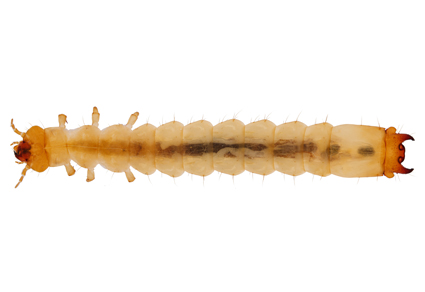Abstract
Larvae of Pseudopyrochroa girardi were collected beneath bark and in coarse, decaying woody debris of dead logs in Ya’an City, Sichuan Province, China. The species association was confirmed by rearing both males and females to the adult stage. The last instar larva is described and illustrated, along with the first description of the adult female. Observations relating to the larval/pupal macro- and microhabitats and natural history are also provided and illustrated. A brief discussion of the significance of such discoveries is presented in relation to the “Mountains of Southwest China” global biodiversity hotspot and conservation implications relating to forests and saproxylic species like Pyrochroidaae.
References
- CEPF (2002) Critical Ecosystem Partnership Fund. Ecosystem Profile. Mountains of Southwest China Hotspot. Available from: https://www.cepf.net/sites/default/files/final.china_.southwestchina.ep_.pdf (accessed 20 December 2022)
- Grove, S. (2002) Saproxylic Insect Ecology and the Sustainable Management of Forests. Annual Review of Ecology and Systematics, 33, 1–23. https://doi.org/10.1146/annurev.ecolsys.33.010802.150507
- Meyers, N., Mittermeier, R.A., Mittermeier, C.G., da Fonseca, G.A.B. & Kent, J. (2000) Biodiversity hotspots for conservation priorities. Nature, 403, 853–858. https://doi.org/10.1038/35002501
- Milberg, P., Bergman, K. & Johansson, H. (2014) Insect Conservation and Diversity, 7, 508–522. https://doi.org/10.1111/icad.12074
- Pan, Z., Duan, J.C., Gao, Q. & Young, D.K. (2021) The adult, larvae, and pupa of a new Pseudopyrochroa (Coleoptera: Pyrochroidae: Pyrochroinae) from China, with Molecular Phylogenetic Inferences. Insects, 12, 1089. https://doi.org/10.3390/insects12121089
- Payne, N.M. (1931) Food requirements for the pupation of two coleopterous larvae, Synchroa punctata Newm. and Dendroides canadensis Lec. (Melandryidae, Pyrochroidae). Entomological News, 42, 13–15.
- Ritchie, H. & Roser, M. (2021) Forests and Deforestation. OurWorldInData.org. Available from: https://ourworldindata.org/forests-and-deforestation (accessed 20 December 2022)
- Shrestha, L.J. & Devkota, M.P. (2015) Sacred groves as important sites for biodiversity conservation in Kathmandu, Nepal. In: Hartmann, M. & Weipert, J. (Eds.), Biodiversität und Naturausstattung im Himalaya. Vol. V. Verein der Freunde & Förderer des Naturkundemuseums Erfurt e.V., Erfurt, pp. 83–88. [https://www.naturkundemuseum-erfurt.de/]
- Young, D.K. (1975) A revision of the family Pyrochroidae (Coleoptera: Heteromera) for North America based on the larvae, pupae and adults. Contributions of the American Entomological Institute, 11 (3), 1–39.
- Young, D.K. (2001) A new species of Pseudopyrochroa (Coleoptera: Pyrochroidae: Pyrochroinae) from China. Oriental Insects, 35 (1), 273–278. https://doi.org/10.1080/00305316.2001.10417305
- Young, D.K. (2014) A new species of Pseudopyrochroa Pic, 1906 (Coleoptera: Pyrochroidae: Pyrochroinae) from the Mae Chaem District, Thailand. Zootaxa, 3785 (1), 95–100. https://doi.org/10.11646/zootaxa.3785.1.8
- Young, D.K., Hsiao, Y., Liang, W.-R. & Lee, C.-F. (2016) Descriptions of the mature larvae for two species of Pseudopyrochroa from Taiwan (Coleoptera: Pyrochroidae: Pyrochroinae), with notes on their natural history. Zootaxa, 4061 (5), 585–595. https://doi.org/10.11646/zootaxa.4061.5.8
- Young, D.K. & Hsiao, Y. (2016) Description of the mature larva of Pseudopyrochroa depressa (Pic) (Coleoptera: Pyrochroidae: Pyrochroinae), with comparison to other Taiwanese Pseudopyrochroa. Zootaxa, 4175 (2), 189–195. http://doi.org/10.11646/zootaxa.4175.2.7
- Young, D.K., Telnov, D. & Pollock, D. (2020) Family Pyrochroidae Latreille, 1806. In Iwan, D. & Löbl, I. (Eds.), Catalogue of Palearctic Coleoptera. Vol.5. Tenebrionoidea. Revised and Updated 2nd Edition; Brill, Leiden and Boston, Massachusetts, pp. 565–569.
- Zhan, Z.-H., Liu, Y.-C. & Young, D.K. (2022) Descriptions of the mature larva and pupa of Pseudopyrochroa facialis (Fairmaire) from Southwest China (Coleoptera: Pyrochroidae: Pyrochroinae), with redescriptions of adult stages and notes on natural history. Zootaxa, 5125 (3), 313–324. https://doi.org/10.11646/zootaxa.5125.3.4


